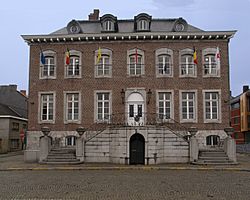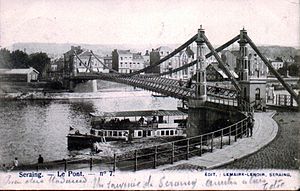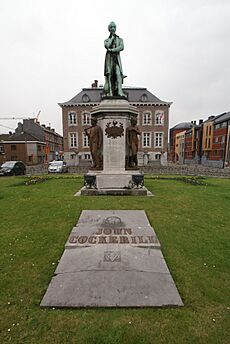Seraing facts for kids
Quick facts for kids
Seraing
Serè (Walloon)
|
|||
|---|---|---|---|

City Hall
|
|||
|
|||
| Country | Belgium | ||
| Community | French Community | ||
| Region | Wallonia | ||
| Province | Liège | ||
| Arrondissement | Liège | ||
| Area | |||
| • Total | 35.34 km2 (13.64 sq mi) | ||
| Population
(2018-01-01)Lua error in Module:Wd at line 1575: attempt to index field 'wikibase' (a nil value).
|
|||
| • Total | Lua error in Module:Wd at line 1,575: attempt to index field 'wikibase' (a nil value). | ||
| Postal codes |
4100, 4101, 4102
|
||
| Area codes | 04 | ||
| Website | www.seraing.be | ||
Seraing (French pronunciation: [səʁɛ̃]; Walloon: Serè) is a city and a municipality in Wallonia, Belgium. It is located in the province of Liège.
The municipality of Seraing includes several areas: Boncelles, Jemeppe-sur-Meuse, Ougrée, and Seraing itself. It is part of a larger urban area called the Greater Liège agglomeration. This big city area has about 600,000 people. South of Seraing, you can find the Condroz and Ardennes regions.
Seraing is famous for its steel factories. It is also home to the Val Saint Lambert crystal factory. This factory has been making beautiful crystal items since 1826. It is built on the site of an old Cistercian abbey. The Arcelor steel company, once known as Cockerill-Sambre, is located where the Prince-Bishopric of Liège used to have its summer home.
Contents
History of Seraing
Lotharingia 956–959
Duchy of Lower Lorraine 959–985
![]() Prince-Bishopric of Liège 985–1789
Prince-Bishopric of Liège 985–1789
![]() Republic of Liège 1789–1791
Republic of Liège 1789–1791
![]() Prince-Bishopric of Liège 1791–1795
Prince-Bishopric of Liège 1791–1795
![]() French Republic 1795–1804
French Republic 1795–1804
![]() French Empire 1804–1815
French Empire 1804–1815
![]() Kingdom of the Netherlands 1815–1830
Kingdom of the Netherlands 1815–1830
![]() Kingdom of Belgium 1830–present
Kingdom of Belgium 1830–present
Early Times and Middle Ages
People have lived in Seraing for a very long time. Skeletons, pottery, weapons, and jewelry from the 5th and 6th centuries have been found here. These items show that Frankish people lived in the area.
The name Saran was first mentioned in 956. At that time, a large farm owned by someone named Saran was given to an abbey. This farm was located on both sides of the Meuse river. Soon after, the entire area became part of the Prince-Bishopric of Liège. This was a territory ruled by a prince-bishop. In the 11th century, a prince-bishop named Henri I of Verdun used a house in Seranus to host guests.
During the Middle Ages, people in Seraing were loyal to Liège. They promised to protect the river if invaders came. In return, they did not have to pay as many taxes. The first wooden bridge across the Meuse river was built in 1381. Before that, people used a ferry to cross.
Industrial Growth

The town's name changed many times over history. The spelling "Seraing" became official in the 18th century. Around this time, Seraing became a great place for industries to grow. This was because of the Industrial Revolution, the nearby Meuse river, and the discovery of coal in Ougrée.
The first ironworks, which are factories that make iron, started in 1809. John Cockerill and his brother James changed the steel industry forever. They started using blast furnaces and coke instead of traditional charcoal. These new methods were the basis for their company, John Cockerill & Cie, which started in Seraing in 1817.
Over the next few decades, many more metal factories were built here. Seraing became a very important part of Wallonia's industrial heartland, known as the sillon industriel. Glassmakers also found the area attractive because coal was cheap and easy to get. The Val Saint Lambert crystal factory began its work in 1826.
Seraing was also the first place in Belgium where the Church of Jesus Christ of Latter-day Saints built a church. Construction started in 1927 and finished by the end of 1930.
Recent Events
In 2012, Seraing was part of the famous 2012 Tour de France. It was the finish line for Stage 1 of the race.
Places to See in Seraing
- The Val Saint Lambert site is a must-see. It includes the old Val-Saint-Lambert Abbey and the crystal factory. Here, skilled workers still blow, carve, and etch beautiful crystal art pieces. Next to it, a castle houses a museum all about glass.
- The Cockerill castle was once the summer home for the prince-bishops of Liège. Later, it was a hospital under Napoleon, then a place to store gunpowder. In 1817, William I of the Netherlands gave it to the Cockerill family.
- The historic center of Seraing also has the city hall and the main church. This church has special baptismal fonts that are over 800 years old!
- South of Seraing, there is a large forested area. It's a great place for walks and hikes.
Local Traditions and Fun Facts
- An old local story says that witches, called macrales (Walloon: macrales), live in the Seraing area. These macrales were brought back to life in 2000 and are now a fun part of local festivals.
- Like many towns in Wallonia, Seraing has its own giant puppet named Li Rayeû d’class.
- Seraing also has many interesting groups. One is a coopers’ brotherhood. Their goal is to bring back the old wineries of the Val Saint Lambert abbey. Another group is the “Gay Boulet” brotherhood. They work to make Boulets à la Liégeoise, a local meatball recipe, famous.
Famous People from Seraing
Many notable people have connections to Seraing:
- John Cockerill (1790–1840): A British businessman who started the Cockerill-Sambre steel company.
- Eugenio Barsanti (1821–1864): An Italian inventor who helped create the internal combustion engine.
- Leo Anton Karl de Ball (1853–1916): A well-known astronomer.
- Julien Lahaut (1884–1950): A communist leader.
- André Renard (1911–1962): A key leader in Belgian labor movements and strikes.
- Christian Piot (b. 1947): A famous football goalkeeper.
- Jean-Pierre and Luc Dardenne (b. 1951 and 1954): Award-winning filmmakers.
- Laurette Onkelinx (b. 1958): A well-known politician.
- Michel Preud'homme (b. 1959): A famous football goalkeeper.
- Gilbert Bodart (b. 1962): A football coach.
- Marc Tarabella (b. 1963): A politician.
- Fabrizio Cassol (b. 1964): A talented saxophone and aulochrome player.
- Marc Laho (b. 1965): An opera singer.
- Michaël Goossens (b. 1973): A football striker.
- Viktor Klonaridis (b. 1992): A football player.
- John Wartique (b. 1990): A racing driver.
Seraing's International Friends
Seraing has "twin town" relationships with other cities around the world. This means they share culture and friendship. Seraing is twinned with:
See also
 In Spanish: Seraing para niños
In Spanish: Seraing para niños







